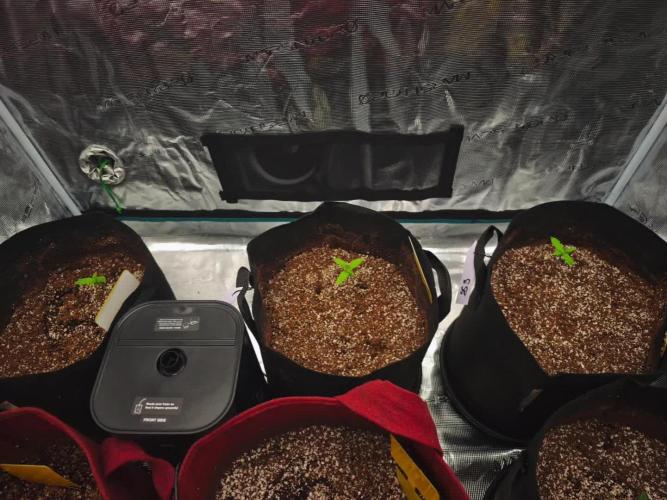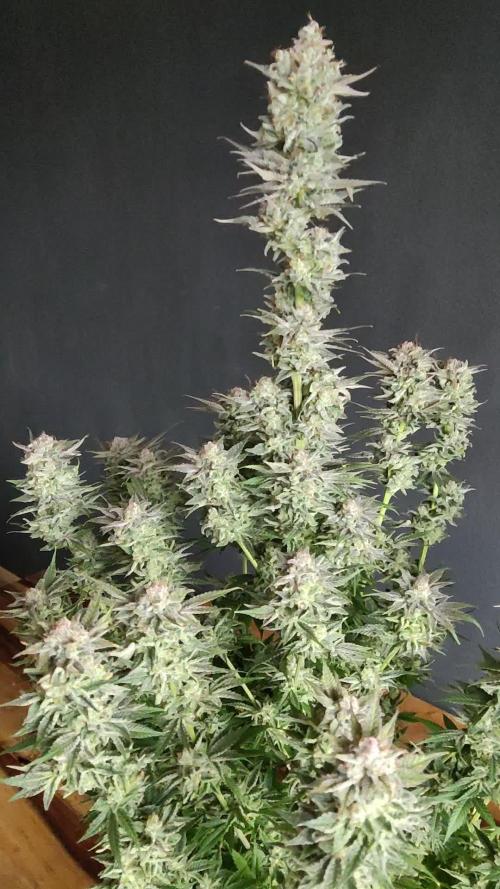The Grow Awards 2026 🏆 























Likes
5
Share


@LeedsCityFarmz
Follow
Not much to report this week so far. Slightly defoliated above the Scrog to allow more light penetration for the lower branches. Plants starting to stretch abit now but nothing to bad.
Likes
12
Share


@SierraKilo1313
Follow
1 GC last stunted survivor, 1 SG stunted survivor and remainder 2 SG and 3 SS are going good let's see where this grow will take us.
I tried germinating Gorilla glue 4 but both of them didn't push through after sowing them.
I might be doing something completely wrong while sowing. Can't push more seeds through germination because the rest of them are at different stages of grow and everything will fall apart.
Let's hope the 7 plants make it through fingers cross.
Review: Plants aren't as green as I would expect them to be either the medium is too inert that they are turning yellow and stunted.
So I tried fixing it with aggressive push of nutes and checked the EC and now it's at a comfortable 0.70 average among all the pots improving from meager 0.20.
Likes
18
Share


@DeepRootsGrowTrees
Follow
PURPLE KUSH / KANNABIA SEEDS
WEEK #16 OVERALL
WEEK #4 FLOWER
This week she's doing great 👍 no issues buds are growing and getting nice trichome coverage!! She's looking healthy 👌!! Stay Growing!!
Thank you for stopping by and taking a look it's much appreciated!!
THANK YOU KANNABIA!!!
KANNABIA / PURPLE
Likes
16
Share


@SkunkyDog420
Follow
Hallo zusammen 🤙.
Habe sie heute geerntet. Wir hören uns in 3 Wochen mit dem Erntebericht.
Likes
Comments
Share


@Yiyis_Grow
Follow
- Luz: Bestva Pro 1000W / 18 h/d
-FloraNova Grow G.Hydroponics: 0.6ml/l
- Armour SI G. Hydroponics 0.4ml/
- Rhizotonic Canna : 4 ml/l
- Everest: 0.5 ml/l
-Sustrato: 2 partes de JIFFY fino con perlita + 1 parte de sustrato universal FLORAGARD
- Diatomea y aguande grifo
Processing
Likes
12
Share


@BloodBath
Follow
I will be focusing this diary on the smoothie strain but you’ll be seeing some other plants in the tent that are not the same strain. I only have room in this tent so bare with me. There are 2 Smoothie, 1 CNC, and 1 Stardawg (dog). The smoothie are the two bigger ones in the back of the tent.
Now, the Smoothie from FastBuds is just killin it right now. Since I popped the beans they have done nothing but show signs of greatness. I don’t think this one is gonna slow down much either.
I’m going to push these plants harder than my last harvest. I had a really really amazing harvest last time. I was even able to pull sap out of all 4 plants. 2 Zkittles and 2 LSD-25. This was all done by feeding at the right times and keeping a “moist” soil. Also I want add that I ran pretty much the entire line of Nectar for the Gods at a little less then the recommended ratios. This time I plan on going a tiny bit over the recommended ratios just to see what these plants will do. Trust me, if the plants have a bad response I will go back to the recommended ratios.
The reason I want to do this is because I really think these auto strains can handle a lot more than a regular flowering cycle plant would. They can handle more stress, that’s for sure.
When do you think I should add a compost tea into my regimen? Soon or wait till the plant is a little larger?
Likes
15
Share


@SmokyPinball
Follow
Growth in early flower stage looks good. Plenty of bud sites. Nutes and LST, then major defoliation in one week.
Likes
3
Share


@therealgrowmie
Follow
We’re closing in on what I’d call the subjectively ideal harvest window. Amber trichomes are now appearing on the sugar leaves, which (by rule of thumb 😄) means the rest are likely cloudy.
The aroma is exactly as expected — like smashing your face into a bowl of cookie dough. That’s modern cultivars for you! 🍪🌱
I’ll be chopping the plants in the next few days and will be back soon with the full harvest report.
---
Grow Conditions (still consistent):
💧 Watering: 1500ml every third day
🌱 Nutrients: None (flushing, previously BioBizz schedule)
💡 Light Intensity: ~1000 PPFD
🌡️ VPD: ~1.82 kPa
🌞 Temperature: ~28°C
💦 Relative Humidity: ~50%
Likes
19
Share


@adam_pawloski87
Follow
Let’s Go Day 81!!!! This week went real great 2 Ogreberrys are hanging to dry and also the Bruce Banner is too after there 48 hr of darkness! The 3 other Ogreberrys began flush on Monday so finish out this week of flush and one more week of flush after that an they will get the chop too! But stay stunned for next week , we’re not done yet so keep them eyes peeled!! Y’all have an amazing productive day as well as a great week ! Peace love an positive vibes to everybody Cheers 😶🌫️💨💨💨💨💨🤙🏻
Likes
53
Share


@Mastr
Follow
She grow super fast this time I think she will be ready day 65 or 70 she already start fatten up and she drank 3L nuts a days
Likes
21
Share


@BLAZED
Follow
Week 18 (30-6 tm 5-7)
30-6
Temperatuur: 31.4 graden (licht aan) 22.5 graden (licht uit)
Luchtvochtigheid: 69% (hoogste) 50% (laagste)
Ik heb de trichomen bekeken en heb besloten haar nog een dagje langer laten staan.
Watergift: Geen.
1-7
Vandaag heb ik de trichomen opnieuw bekeken en die zien er goed uit! Veel cloudy en best wel wat amber.
Ik hou echt van deze trichome foto's, echt mind blowing hoe dat er uit ziet!
Dus vandaag gaat de schaar er in!
2-7
Ik heb besloten om een wet trim te doen zodat als ze droog is ze gelijk in de cure pot kan.
Geloof het of niet, maar ik ben wel 12 uur lang bezig geweest om alles te knippen 😅
Op 1-7 ben ik in de middag begonnen en in de vroege ochtend van 2-7 was ik klaar.
Het natte gewicht van de buds is 283 gram, en het natte gewicht van de trim is 61 gram.
Ik ben nu al super tevreden met het gewicht! Dit is meer dan het dubbele aan gewicht vergeleken met mijn eerste grow.
De buds zien er ook echt mooi uit. Ik schat dat het tussen de 50 en 75 gram droog gaat zijn. Ik ben benieuwd, nu een paar dagen drogen!
Droogtent:
Temperatuur: 23.4 graden (hoogste) 21.2 graden (laagste)
Luchtvochtigheid: 59% (hoogste) 42% (laagste)
3-7
Droogtent:
Temperatuur: 23.2 graden (hoogste) 21.5 graden (laagste)
Luchtvochtigheid: 50% (hoogste) 41% (laagste)
4-7
Droogtent:
Temperatuur: 23.1 graden (hoogste) 22.1 graden (laagste)
Luchtvochtigheid: 53% (hoogste) 46% (laagste)
5-7
Na 3 dagen is ze droog genoeg om te curen. Wel heb ik iets te lang gewacht want de LV in de jar geeft nu 57% aan.
Ik hoop dat dit over een dag wat om hoog gaat. Nu een paar weken curen en dan kom ik met de rook verslag 😁
Ik zal binnenkort ook even berekenen wat de gram per watt is, aangezien ik de lamp niet de gehele grow op 100% had staan.
Het droge gewicht van de buds is precies 75 gram, en het droge gewicht van de trim is 19 gram.
Samen maakt dat 94 gram! (De trim gebruik ik om een CBD cake of bubble hasj te maken)
Ik wil iedereen bedanken voor het volgen van dit avontuur! Tot de volgende keer!
Likes
7
Share


@ShotoCann
Follow
Sorry it took so long for an update. I got married in the meantime and went on a honeymoon. Before I went though I took the plants down and had a friend take care of the drying and curing.
It looks like I got 2 pheno's. One is has more red hairs and is a bit more skunky and peppery. The other has bit more sativa like bud forming and smells a bitt gassy in addition to the tangieness.
The yield is also definitely not disappointing.
Plant 1: 76gr
Plant 2: 68gr
Plant 3: 65gr
Total:209gr
I am happy with that. Especially since it's my first LED grow.




































